Nakajima Ki-43-IIb Hayabusa (Oscar)
As with the Japanese Navy’s A6M Zero fighter the Army’s Ki-43 Hayabusa or Peregrine Falcon came as a shock to American and British pilots when war broke out in the Pacific in 1941. The low wing, all metal monoplane fighter was more maneuverable and faster than most of the fighters available to the Allies at the beginning of the war. Development of the aircraft began in 1937 and it entered service in late 1941. During the war the Allies used a code name reporting system for identifying Japanese aircraft. Under this system the Ki-43 was named “Oscar.” The Ki-43-II version of the aircraft introduced several improvements to the aircraft. The most significant of these was the addition of armor to the cockpit and self-sealing fuel tanks. All the versions of the Hayabusa were under armed mounting only two machine guns in the nose of the aircraft. By late 1943 the Ki-43 was outclassed by many of the fighters being put into service by the Allies. Despite this it remained in production and service until the end of the war.
Wingspan | 35 ft 6 in. |
Length | 29 ft 3 in. |
Height | 10 ft 8 in. |
Weight | 5,710 lbs (loaded) |
Maximum Speed | 329 MPH |
Service Ceiling | 36,750 ft |
Range | 1,095 miles |
Engine | One Nakajima Ha-115 radial with 1,150 horsepower |
Crew | 1 |
Manufacturer
Nakajima
Markings
Imperial Japanese Army Air Force 63rd Sentai, Hollandia, New Guinea, 1944
Designation
Ki-43-IIb
Serial Number
6430
